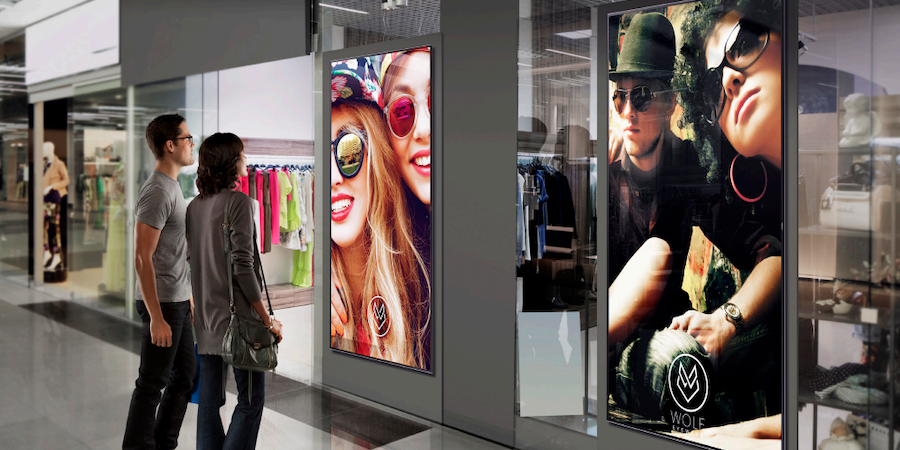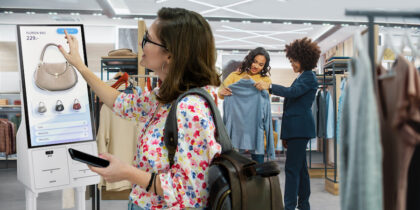Shopping has undoubtedly changed in the digital age — and it’s continuing to evolve. With the widespread shift to online shopping, customers have myriad purchasing options that were unavailable a few years ago, like mobile ordering, contactless checkout and buy online, pick up in-store (BOPIS). Retailers are getting used to thinking outside the box when it comes to connecting with their customers.
As they anticipate consumer behavior, the future of the retail industry is moving away from a reactive approach to a proactive one: “How do we create a connected shopping experience?”
Digital solutions allow retailers to present information to customers in new, engaging ways, bringing the power of e-commerce and omnichannel branding into brick-and-mortar stores. At the National Retail Federation (NRF) conference in January 2023, Samsung will showcase the latest retail technology innovations that let retailers future-proof their business for years to come.
Data, AI and sensors personalize the customer experience
There’s no better way to understand consumer trends than to collect and analyze real-time data. In retail, first-party consumer data is the holy grail of brand marketing. With this valuable information, retailers can accurately identify customer preferences and create personalized in-store messaging, similar to the customized messaging and offers they employ online.
Another innovative source of real-time data, heat mapping technology such as FastSensor lets retailers see how customers move throughout the store — without collecting any personal information about individual people. These sensors use radio frequency to document where shoppers linger and for how long, so retailers can adjust the store layout and promotional displays more effectively. Similar to the data retailers collect on their website, FastSensor provides information on movement throughout the store — and what messages at what time spur purchases. Stores can use this data to strategically add digital signage to attract shoppers to less busy areas of the store, then optimize content on screens to increase sales and improve traffic flow. This integrated retail technology helps connect the customer journey while showing retailers the ROI of their digital investment.
The future of retail is digital
Get your free guide to growing your retail business by adopting future-proof ecommerce technology. Download Now
Retailers can also leverage real-time data to create spot offers, delivered with on-shelf digital signage. If a customer lingers in front of a particular product, the display might share a message about a relevant deal or discount. And when the customer walks away from the display, the promotion disappears, so it isn’t automatically shown to the next shopper who’s just passing by. Harnessing the power of social media, on-shelf digital signage can also display image-driven posts with curated user testimonials.
All of this data can be organized with software like BlueForce, which visualizes data in custom dashboards, and can connect in-store traffic data to external factors like weather and time of day.
Kiosks and QR codes streamline operations
Today, most people want to be able to shop on their own. These independent shopping experiences should be unique as well as satisfying.
Consider QR codes: The technology wasn’t ubiquitous until 2020, but they provide a simple and effective way to make shopping more immersive and operations more efficient. In home improvement stores, for example, QR codes can show shoppers all of the necessary materials they need for their DIY project, consolidated onto one digital page alongside the location of each of those items. The future of retail is all about shopping efficiently and avoiding return trips to dramatically increase customer satisfaction.
As for managing returns, self-service kiosks allow customers to complete the process themselves, rather than wait in line for a cashier. They simply scan the barcode at the kiosk, drop the item in the return bin and take their return receipt. These same kiosks also help free retail associates to focus on more pressing tasks.
EV charging stations attract in-person customers
As electric vehicles (EVs) continue to gain momentum, store-adjacent charging stations can ease drivers’ anxiety about their car batteries. And equipped with state-of-the-art outdoor digital signage, these charging stations are another opportunity to engage with passersby, providing information about promotional sales and limited-time offers (LTOs). To offset the cost of installation, retailers can opt to sell ad space to partner brands. These displays can also be integrated with a retail loyalty app to notify customers when their car is fully charged and ready to roll.
Preparing for what’s ahead
On the other side of the digital metamorphosis that retailers were forced to undergo the past few years are opportunities to better engage with people, make their lives easier and create more enjoyable shopping experiences. Digital signage offers endless possibilities to communicate with customers in the moment. The stores of the future will be truly immersive, offering customers information and opportunities that are specifically relevant to them.
Discover the full range of Samsung’s retail display solutions, each designed for cost-effective impact and versatility. And get your free guide to growing your retail business by adopting future-proof, e-commerce technology.








